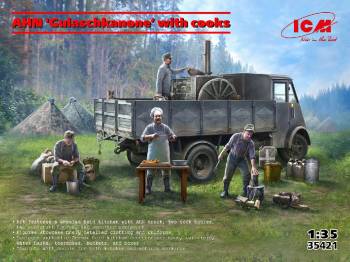1/35 AHN 'Gulaschkanone' w/cooks
|
|
 |
But only from... ICM Models
All items from... ICM Models
Among the many factors that determine the course of battles, one is not immediately obvious but is crucial—food supply in combat conditions. A quality hot meal for a soldier is of great importance and sometimes influences the combat effectiveness of units more than modern weapons or equipment. Taking this into account, the Wehrmacht paid significant attention to soldier nutrition during wartime. In combat conditions or during marches, field kitchens on wheels of various types were used: large kitchens for 125 to 225 personnel, and smaller kitchens for 60 to 125 soldiers. These kitchens were either transported on trailers pulled by vehicles or horse-drawn wagons. They were also frequently set up in the beds of different trucks. These kitchens, humorously referred to by soldiers as the ‘Gulaschkanone,’ allowed for the preparation of various dishes. A large kettle, which had an insulating layer (usually made of glycerin), was used for the main dishes, and later versions of the kitchens included a separate kettle for frying. Meals were distributed either directly into soldiers’ mess kits or into large thermoses for delivery to units located some distance away from the kitchen. The main part of the daily ration was usually served at lunch, which could include, for example, a meat soup, a serving of potatoes with a generous portion of meat, and vegetables. It was also common practice to requisition food from the local population to improve the soldiers’ rations beyond the established norms.







